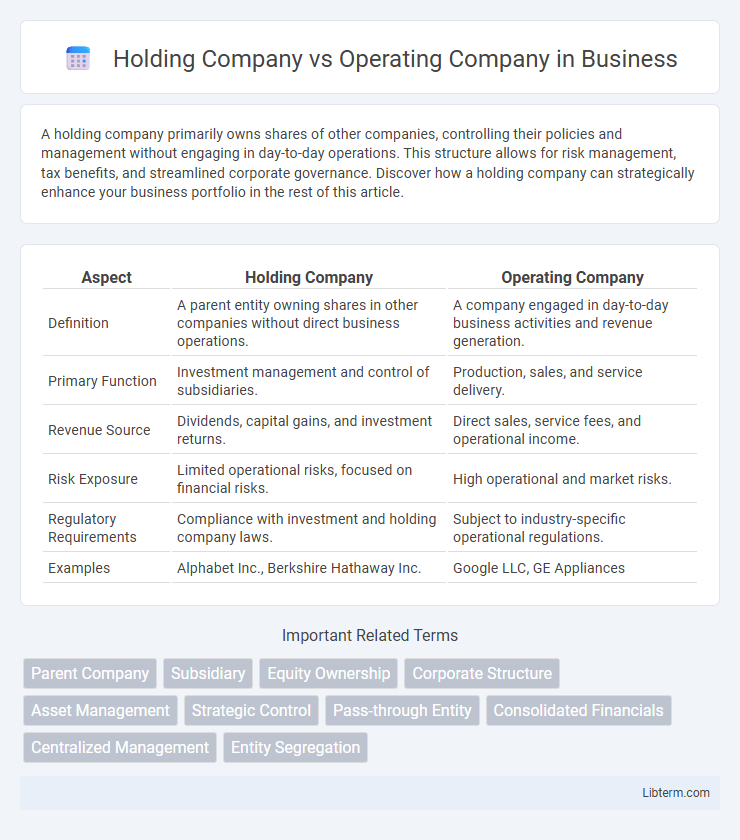A holding company primarily owns shares of other companies, controlling their policies and management without engaging in day-to-day operations. This structure allows for risk management, tax benefits, and streamlined corporate governance. Discover how a holding company can strategically enhance your business portfolio in the rest of this article.
Table of Comparison
| Aspect | Holding Company | Operating Company |
|---|---|---|
| Definition | A parent entity owning shares in other companies without direct business operations. | A company engaged in day-to-day business activities and revenue generation. |
| Primary Function | Investment management and control of subsidiaries. | Production, sales, and service delivery. |
| Revenue Source | Dividends, capital gains, and investment returns. | Direct sales, service fees, and operational income. |
| Risk Exposure | Limited operational risks, focused on financial risks. | High operational and market risks. |
| Regulatory Requirements | Compliance with investment and holding company laws. | Subject to industry-specific operational regulations. |
| Examples | Alphabet Inc., Berkshire Hathaway Inc. | Google LLC, GE Appliances |
Introduction to Holding and Operating Companies
A holding company primarily owns shares of other companies to control their policies and management without engaging in daily operations, which optimizes asset protection and investment diversification. In contrast, an operating company actively engages in producing goods or services, managing business activities, and generating revenue through its core operations. Understanding the distinction helps in structuring corporate strategies for tax benefits, liability management, and operational focus.
Definition of a Holding Company
A holding company is a business entity created primarily to own shares of other companies, controlling their policies and management without directly engaging in day-to-day operations. It typically holds the majority of voting stock in subsidiary companies to influence decisions and protect investments. Unlike operating companies, holding companies generate revenue mainly from dividends, interest, and capital gains rather than through direct commercial activities.
Definition of an Operating Company
An operating company is a business entity that actively engages in providing goods or services to customers, generating revenue through its core operations. Unlike a holding company, which primarily owns shares of other companies, an operating company manages day-to-day activities, including production, sales, and customer service. Key examples include manufacturing firms, retailers, and service providers directly involved in market transactions.
Key Differences Between Holding and Operating Companies
Holding companies primarily own shares of other companies to control their policies and management without directly engaging in daily business operations. Operating companies focus on producing goods or services, managing day-to-day activities, and generating revenue through core business functions. Key differences include ownership structure, with holding companies often having multiple subsidiaries, and operational involvement, where operating companies are actively involved in business execution.
Legal Structure and Ownership
A holding company primarily owns shares of other companies, maintaining control without engaging in day-to-day operations, which limits its direct legal liabilities. An operating company actively manages business activities, bearing full legal responsibilities for operational decisions and regulatory compliance. Ownership in holding companies often spans multiple subsidiaries, creating a layered legal structure, while operating companies focus ownership on direct asset management and business execution.
Financial Management and Tax Implications
A holding company primarily manages investments and controls subsidiaries, optimizing financial management through consolidated cash flow and centralized risk mitigation, which can lead to improved capital allocation efficiency. Tax implications favor holding companies by enabling tax deferral, dividend income exemptions, and strategic loss utilization across subsidiaries, reducing overall corporate tax liability. Operating companies, in contrast, focus on direct business activities with more immediate tax responsibilities and less flexibility in financial structuring or tax planning.
Risk and Liability Distribution
A Holding Company primarily assumes financial risks by owning controlling shares in subsidiaries, limiting its liability to the extent of its investment and isolating operational risks within each operating company. Operating Companies directly manage day-to-day business activities and bear full operational liabilities, including product liability, employee claims, and regulatory compliance risks. Structuring as a holding company effectively shields parent assets from lawsuits or debts incurred by operating entities, optimizing risk management across the corporate group.
Advantages of a Holding Company Structure
A holding company structure offers significant advantages such as centralized control over multiple subsidiaries, which enhances strategic decision-making and risk management. It facilitates asset protection by isolating liabilities within individual operating companies, reducing the risk of financial contagion. Tax benefits and streamlined capital allocation also improve overall operational efficiency and investor appeal.
Disadvantages and Challenges of Each Model
Holding companies face challenges such as limited direct control over subsidiaries, which can lead to coordination issues and slower decision-making processes. Operating companies often deal with high operational risks, including market volatility and the burden of managing day-to-day business activities. Each model presents financial risks: holding companies risk asset depreciation within subsidiaries, while operating companies encounter concentrated exposure to industry-specific downturns.
Choosing the Right Structure for Your Business
Selecting the appropriate business structure between a holding company and an operating company depends on your strategic goals and risk tolerance. Holding companies offer benefits such as asset protection, tax advantages, and centralized management of subsidiaries, making them ideal for diversified investments and risk isolation. Operating companies focus on day-to-day business activities and revenue generation, suitable for businesses aiming for direct market engagement and operational control.
Holding Company Infographic

 libterm.com
libterm.com